
<<< Back to Index
News
 https://www.facebook.com/ChestercastleandAgricolatower
https://www.facebook.com/ChestercastleandAgricolatower
380th Anniversary great siege of Chester
20th and 21st September 2025
11am Chester Castle 2pm Roman Gardens
We will be supporting this weekend coming 20th and 21st September 2025 to help commemorate the 380th anniversary great siege of Chester during the English Civil War.
With our own 17th century clothed interpreters on site over the weekend, the commemoration on Sunday the 21st will be special.
In conjunction Heritage open days and Heritage Chester.

 https://www.facebook.com/ChestercastleandAgricolatower
https://www.facebook.com/ChestercastleandAgricolatower
380th Anniversary great siege of Chester
20th and 21st September 2025
11am Chester Castle 2pm Roman Gardens
We will be supporting this weekend coming 20th and 21st September 2025 to help commemorate the 380th anniversary great siege of Chester during the English Civil War.
With our own 17th century clothed interpreters on site over the weekend, the commemoration on Sunday the 21st will be special.
In conjunction Heritage open days and Heritage Chester.

https://www.activeleisureevents.co.uk/marathon


 Facebook - Chester Marathon
Facebook - Chester Marathon
 https://x.com/chestermarathon
https://x.com/chestermarathon
Start : Chester Racecourse
Finish : Castle Drive Chester
MBNA Chester Marathon
TBA 2025
9am–3pm
Location : The Racecourse, Town/City, Chester Area.
The multi-award winning and sell-out MBNA Chester Marathon will return in 2025.
We have developed an enviable reputation with runners of all levels.
We are looking forward to the 13th MBNA Chester Marathon. Our spectacular marathon route is both historic and scenic.
Runners leave the racecourse and head into the City centre passing the Town Hall, Cathedral, split level Middle Ages "Rows", Eastgate Clock.
The MBNA Chester Marathon is the UK's favourite marathon (less than 5000 runners), Three Running Awards.
With a spectacular start and finish very near Chester Racecourse, the route passes all Chester's iconic landmarks,
then heads out into the Cheshire & North Wales countryside, before returning along the banks of the River Dee for an unforgettable finish.
All finishers will receive a technical t shirt, bespoke medal and a goody bag.
Active Travel Festival
www.atfest.uk
Free
TBA 2025
Castle Square Lower Car Park CH1 2DN Chester
Chester Green Weekend
www.greenexpo.uk
Free
7th and 8th June 2025
Riverside
Castle Drive
Chester
Chester Castle
Chester Castle
Grosvenor Street
Chester City Centre
Cheshire
CH1 2DN
Chester Castle
Grosvenor Street
Chester City Centre
Cheshire
CH1 2DN
Chester Pride
www.chesterpride.co.uk
Chester Pride
2023 TBA
Chester Castle
Lower Car Park
Art Exhibition
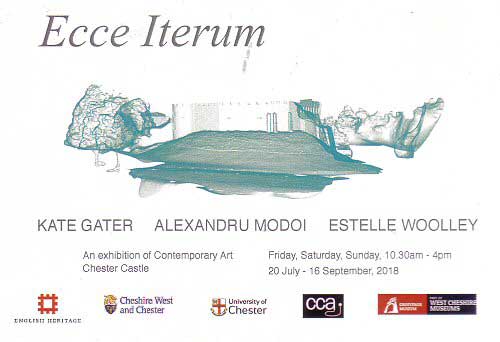
www.chesterpride.co.uk
Chester Pride
2023 TBA
Chester Castle
Lower Car Park
Art Exhibition


Access to Chester Castle is only available via the Secret Chester Tour three days a week
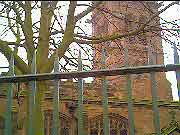
 |
Chester Castle was founded on a small sandstone hill in the south west corner of the city walls in 1070 by William the Conqueror. It was the royal base for the military conquest of North Wales.

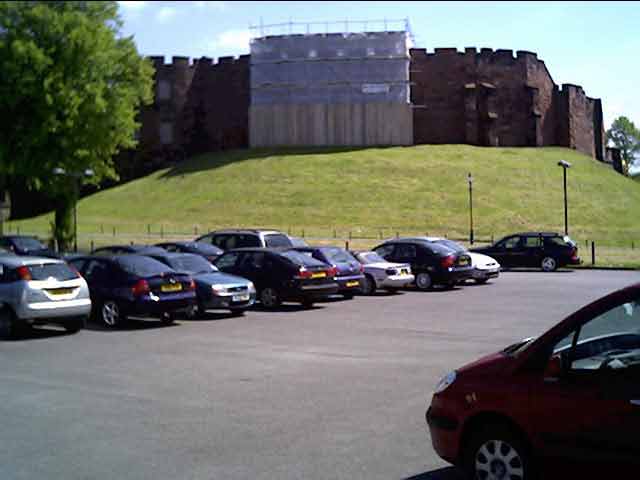


Model of the Grosvenor Bridge located near the castle
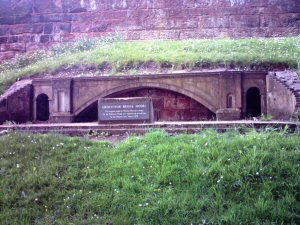
The Outer Bailey of the Castle
Chester Crown Courts now occupy the outer bailey of the Castle. Outside of the main Castle entrance is a roundabout.
Joining the roundabout is the A483 Grosvenor Road, Grosvenor Street, A5268 Nicholas Street.


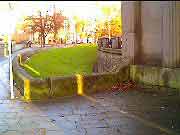
Around the corner is Castle Street. Which has the Golden Eagle Pub on it. From here you can access Bridge Street.
Click on the picture for information on Bridge Street More >>>
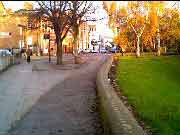

Golden Eagle
Chester
Traditional Pub with Jukebox
Traditional pub in the heart of the City
ChesterTourist.com Rating 


If you cross Grosvenor Road at the crossing (be careful this road is very busy) you can access Chester Race Course from Nuns Road. Click on the picture for information on Chester Race Course More >>>

Cheshire Regimental museum is located in the car park of the crown court. Also behind the castle is old St Mary's Church. Which is now used as an educational centre and is owned be Cheshire County Council.
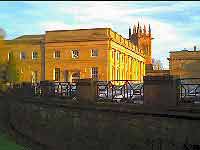
Click on the picture for more information on St Mary's on the hill

Chester Crown Courts
The Castle
Chester
CH1 2AN
01244 317 606
The Castle
Chester
CH1 2AN
01244 317 606
Parking in front of the courts.
http://www.hmcourts-service.gov.uk
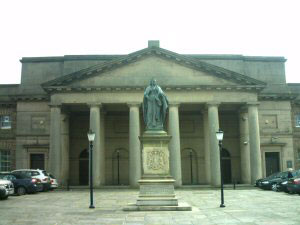
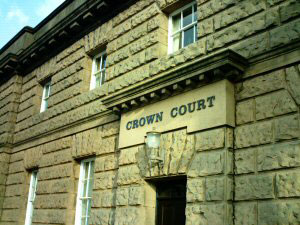

![]() Date Visited 14th July 2023
Date Visited 14th July 2023
Cheshire Military Museum
The Castle
Chester
CH1 2DN
01244 327 617
www.cheshiremilitarymuseum.co.uk
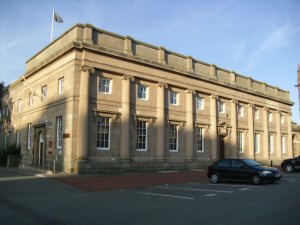
Chester
CH1 2DN
01244 327 617
www.cheshiremilitarymuseum.co.uk

![]() Date Visited 13th August 2022
Date Visited 13th August 2022
Inside Chester Castle



Chester Castle Information board.

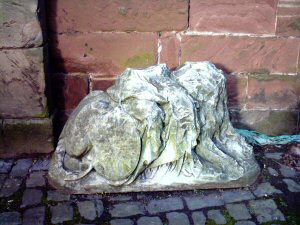





Agricola's Tower or Julius Caesar's Tower 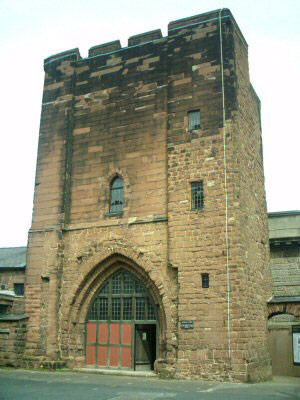

 | Chester Castle is located on the Southeast corner of the City Walls on a small sandstone hill overlooking the river. There may have been a Roman auxiliary fort built on the spot in AD 79. In 1069 William the Conqueror had the castle built. Much of the Medieval castle has been rebuilt in later times. In 1790 whole of the medieval castle except the walls of the upper bailey and Agicola's tower were demolished. Chester Crown Courts are situated in the outer bailey.Chester Castle appears not to be open to the public much these days. This bank holiday Monday I took the opportunity to have a look inside the castle. The parts of the castle that are open to visitors are: The Guardroom, Agricola's Tower, The Chapel of St. Mary De Castro and the Battlements. |
The Guardroom
 | The Guardroom is located next to Agicola's tower. It consists of a room and a small number of white washed cells. There is a reconstruction of a guard in period clothing looking into one of the cells.In the room as you go through the door are panels displaying the periods of history of the castle. They are well worth a read. |
 |

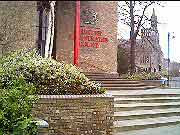 |
Agricola's Tower
 | Agricola's Tower or Julius Caesar's Tower is one of the only original surviving parts of the Norman Castle. It is located in the upper bailey of the castle. And has a large arched entranceway.When the tower was refaced in 1837. The foundations of one of the corners was found to be built on a Roman arch. In 1831 a small piece of a Roman tombstone was found in the wall near the southeast part of the tower. |
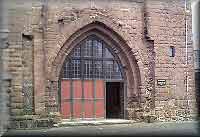
|
The Chapel of St. Mary De Castro

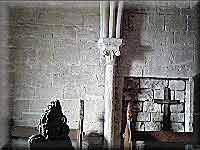


| The Chapel of St. Mary De Castro is located in the upper part of Agricola's Tower. It is accessible by a spiral stone stair case from the bottom room. The chapel is now a plain upper chamber which has a vaulted and groined stone roof supported by slender pillars with decorated capitals.The Chapel is only open by appointment. But you can see it through the bars across chapel door. It was built as a private chapel for the Earls of Chester. It contains a wooden cross of a soldier killed in France 1914-1918. The brass cross on the altar is dedicated to Captain Collins of the 2nd Battalion. Killed in the South African war 1899-1902. James II attended mass here on the 28th August 1687. The Chapel was deconsecrated and used as an ammunition and gunpowder store until 1921. It was reconsecrated in 1925. The Chapel has fragments of high quality frescos dating from around the 1230's. From the time of Earl Rannulf III. The frescos are of exceptional quality and are unusually small reminiscent of contemporary stained glass and manuscript illumination. On the north wall there are parts of an ecclesiastical scene. Telling the story of the priest who was unable to remember any mass other than that of the virgin. And also the story of Ebbo the penitent thief. The virgin supported him for two days to save him from hanging. The south wall tells the story of the boy of Bourges. The west wall tells the tale of Theophilus. Just the head of the bishop is visible. The east wall there is an unidentified scene from the 12th century with a man in a wide brimmed hat. In the altar recess are the remains of a crucifixion scene. The Chapel is now used as the regimental chapel of the 22nd Cheshire Regiment. The Frescos are hard to see. There is an information panel with pictures in the down stairs room. |
Door to the Chapel.
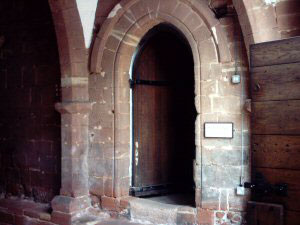
The Chapel is accessed by a spiral staircase.
Fresco fragment.
The Altar.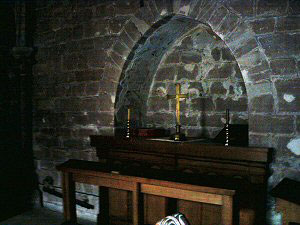
Information Board.
You cannot go into the Chapel, but you can view it through an iron grill.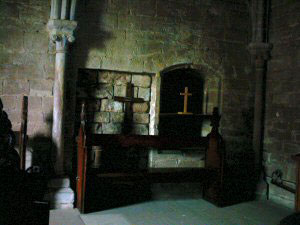
The Battlements




BLM


https://en.wikipedia.org/wiki/Stapleton_Cotton,_1st_Viscount_Combermere

The Rear
At the rear of Chester Castle is County Hall the home of Cheshire County Council


You can join the walls at this point

You can also see Handbridge from across the River.
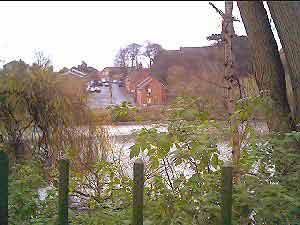
The road that runs along side the Castle and around the back to the Old Dee Bridge is called Castle Drive.

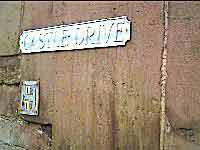
Click on the picture to enter Bridge Street

Other Castles in the area
Holt Castle

Beeston Castle.
Click on the picture for more information

Chester Magistrates Court

Beeston Castle.
Click on the picture for more information

Chester Magistrates Court

 |


Chester Pride Event
 https://www.facebook.com/chesterprideuk/?locale=en_GB
https://www.facebook.com/chesterprideuk/?locale=en_GB
 https://www.facebook.com/chesterprideuk/?locale=en_GB
https://www.facebook.com/chesterprideuk/?locale=en_GB
The Castle Car Park will be closed for this event.
Chester Pride
Free annual two day weekend event with parade, stalls and live music in Chester Castle Car Parks. In Chester City Centre about ten minutes walk from The Cross.
Saturday 17th August 2024
 https://en-gb.facebook.com/chesterprideuk/
https://en-gb.facebook.com/chesterprideuk/
Chester Castle Square, Off Grosvenor Street, Chester, Cheshire, England, CH1 2DN, U.K.

01244 257 602
info@chesterpride.co.uk
https://www.facebook.com/chesterprideuk/
Chester Pride 2025
Reviews
 Date Visited 5th November 2022
Date Visited 5th November 2022
External Links
www.thecrownestate.co.uk
External Links
www.thecrownestate.co.uk
http://www.english-heritage.org.uk/daysout/properties/chester-castle-agricola-tower-and-castle-walls
This page was last updated












 © 2025 Button IT Net
© 2025 Button IT Net